My mom and dad, Pat and Keith, are 88 and 87 years old respectively. We spent Mother’s Day 2013 in Seattle filming their life stories. The timing was perfect for a family gathering and reliving good ol’ Howell adventures.
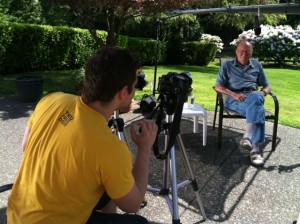
My dad retired at the age of 60, following an accomplished career as a civil engineer in the heavy construction industry. He was a Partner and President of Constructors PAMCO headquartered in Seattle, Washington. Among my dad’s many marvelous construction feats, the most memorable to me are his building landing strips in Barrow, Alaska; tunneling throughout the Pacific Northwest in an effort to help plumb the region with water, sewer and irrigation lines; and boring the overflows of the Glen Canyon Dam in Arizona.
In recollection of his decades of professional achievements, I asked him what his secret to success was. He said, “Well, it’s certainly not smarts. I was a C+ student my whole life, but I was always around smart people who did really good things for me. If it wasn’t for them, our family wouldn’t have enjoyed any of this.”
Keith is more modest than he is truthful, and I’ve never known him to tell a lie. The fact is that he is smart, honest, industrious, and one of the most creative people I have ever known. He also operated with an important principle in business: “A deal is only good if it’s good for both parties.”
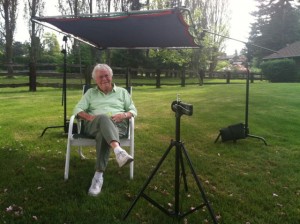
My mom is even more understated than my dad. She was a nurse in Hawaii after WWII and then graduated from the University of Michigan as a nurse anesthetist. She met and married my dad, then had seven kids in nine years (yes, you read that correctly), and was an avid golfer until her mid 80’s. She also brought sex education to St. Brendan’s Catholic School when I was in the seventh grade. The Vatican has never quite been the same. God bless her.
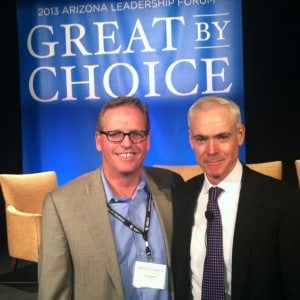 When I returned to Phoenix from Seattle, with the hours of interviews still fresh in my mind, I picked up an article by Jim Collins, the author of Good to Great, Why Some Companies Make the Leap… and Others Don’t. His particular article in the Harvard Business Review focused on Level 5 Leadership. Collins describes the Level 5 Leader as the CEO who “builds enduring greatness through a paradoxical combination of personal humility plus professional will…a study in duality: modest and willful, shy and fearless.” Bam! That’s my dad. He is a combination of completely unrelated and sometimes opposing parts that combine to make an even greater whole.
When I returned to Phoenix from Seattle, with the hours of interviews still fresh in my mind, I picked up an article by Jim Collins, the author of Good to Great, Why Some Companies Make the Leap… and Others Don’t. His particular article in the Harvard Business Review focused on Level 5 Leadership. Collins describes the Level 5 Leader as the CEO who “builds enduring greatness through a paradoxical combination of personal humility plus professional will…a study in duality: modest and willful, shy and fearless.” Bam! That’s my dad. He is a combination of completely unrelated and sometimes opposing parts that combine to make an even greater whole.
Much like my dad, there have been many a time that I have felt like I’m not the smartest guy in the room. The successes I have enjoyed are a result of the talent and earnest effort of the good people around me. One thing I can do pretty well is connect dots that are often not seen by others and find those people who can help make great things happen. Things just sort of “click” for me in my mind, and I’ve become pretty good at gauging people’s intentions and willingness to do good in the world.
 Daniel Pink, author of five stirring books on how business and the work environment are changing, first identified a 1+1=3 virtue as part of the new “Conceptual Age” in his book, A Whole New Mind. Pink’s premise is that in the 18th century we had the “Age of Agriculture”, where the economy was built on the backs of farmers. The 19th century ushered in the “Industrial Age”, which was also built on the backs of workers but required new styles of engineering and thinking to create and expand the concepts related to assembly lines and automation. This shift was as a result of accommodating greater volume in commerce and a growing economy.
Daniel Pink, author of five stirring books on how business and the work environment are changing, first identified a 1+1=3 virtue as part of the new “Conceptual Age” in his book, A Whole New Mind. Pink’s premise is that in the 18th century we had the “Age of Agriculture”, where the economy was built on the backs of farmers. The 19th century ushered in the “Industrial Age”, which was also built on the backs of workers but required new styles of engineering and thinking to create and expand the concepts related to assembly lines and automation. This shift was as a result of accommodating greater volume in commerce and a growing economy.
In the 20th century, automation created the need for more knowledge workers like software designers and developers, and the “Information Age” was born. Heavy lifting gave way to technology that could do the work of many men and women. Today, in the 21st century, American knowledge-based work is being outsourced to Asia, South America, and other emerging markets. More types of work are being automated through computer programs, cloud computing and the internet (all created by those who are now being replaced by their creation). Ironic, isn’t it? According to Pink, the Information Age is naturally evolving to the “Conceptual Age”, where a person’s ability to connect the dots in business, as in life, is king. For example, it is not unusual to find a business consultant working at McKinsey & Company with a background in Biological Sciences. As such, the “connecting of dots” is using observations and theory from biology (understanding how organisms behave) and applying it to the business sector. Pink describes this shift as follows:
“The last few decades have belonged to a certain kind of person with a certain kind of mind – computer programmers who could crank code, lawyers who could craft contracts, MBAs who could crunch numbers. But the keys to the kingdom are changing hands. The future belongs to a very different kind of person with a very different kind of mind – creators and empathizers, pattern recognizers, and meaning makers. These people – artists, inventors, designers, storytellers, caregivers, consolers, big picture thinkers – will now reap society’s richest rewards and share its greatest joys.”
I sure hope Pink is right because this is how I think naturally. I wasn’t a gifted student – actually, kind of a lazy one. I’m not a fast reader, nor am I particularly good at math. I remember hitting rock bottom in school when I got an F on a journalism test in college that I had actually studied hard for. Despite all of my educational misadventures, I earned two Bachelors of Art Degrees in Communications and Music Composition and Theory from Washington State University in just over four years.
The ability to synthesize ideas and concepts to find rhythms and patterns in life and business is not something I taught myself. It’s the way I’m wired. It’s like a latent talent of creating the perfect Baked Alaska or riding a unicycle while playing a ukulele: a hidden skill you never knew you had until it materializes right before your eyes because of a dare or in the act of satisfying your desire or challenge to do more than you thought possible. I’ve learned that the more intentional I am in the business of dot-connecting, and the more I work at it by unleashing my curiosity to let it roam free, the more profound I find the outcomes and connections to be.
Throughout my life, I’ve learned that when I’m not the smartest guy in the room, I need a secret weapon. My ninja skill is the ability to conjure up the magic that life creates when you combine two unrelated things to make a third and more powerful thing and then share it through the power of storytelling.
I’ve heard similar processes called “designed serendipity”. For grins, I’ll call it “Mojosynthesis.” I think of it to be similar to photosynthesis, the process used by plants to convert light energy, normally from the sun, into chemical energy to help the organism thrive. I created the more hip and campy name, mojosynthesis to describe the process of tapping into the brilliance of others, and cross pollinating their wisdom to create new constructs, rhythms and patterns to help people thrive in their professional and personal pursuits.
Here is an example. Before I started Park&Co, I was the Creative Director at a direct selling firm called Quorum International. Upon my first day on the job of this fast-growing, start-up in the electronics industry, I was led to slaughter. The “slaughterhouse” was actually a boardroom filled with anxious product managers and their sycophants preparing for an enormous product launch. As their new creative leader, they all turned to me for help. The Quorum team was to launch five new products in under two months, and we had virtually no packaging design, no creative concepts or marketing materials, and no instructional manuals or launch videos. We had bupkis! They looked to me as if I was their savior, and yet I thought I was the dumbest guy in the room. I knew next to nothing about the company, nor did I have an inkling about its new product launches or the people lunging at me with their requests for creative brilliance. I squirmed, to say the least.
 Then I remembered a conversation with my wife’s dad, Major James Reynolds, who was a decorated fighter pilot in World War II, Korea and Vietnam. I suppose he popped into my mind because I felt under fire. He had mentioned that when a pilot becomes lost in flight, that they are instructed to follow the Five C’s: climb, conserve, communicate, confess and comply. Climb to a safe altitude to keep out of the mountains, then throttle back to Conserve fuel. Communicate with local air traffic control. Confess that you’re lost so they understand your situation, and Comply with their instructions.
Then I remembered a conversation with my wife’s dad, Major James Reynolds, who was a decorated fighter pilot in World War II, Korea and Vietnam. I suppose he popped into my mind because I felt under fire. He had mentioned that when a pilot becomes lost in flight, that they are instructed to follow the Five C’s: climb, conserve, communicate, confess and comply. Climb to a safe altitude to keep out of the mountains, then throttle back to Conserve fuel. Communicate with local air traffic control. Confess that you’re lost so they understand your situation, and Comply with their instructions.
Have I lost you yet? Hang with me. This is actually going somewhere.
Since I was lost in this boardroom atmosphere, my mind leaped to the completely unrelated pilot training of my father-in-law, and I decided to use it. I mentally climbed above the fray. Instead of joining the conversation completely uninformed, I conserved my energy by simply listening to everyone. I must have sat there for 45 minutes without saying a word. My own assistant, who I had known for all of two hours, kept shooting me nervous glances to see how I was handling the situation and what my evasive maneuvers might be.
I was amazed at what I learned about the personalities in the room from my U2 spy plane position. I could start to see who was worth listening to and who was not, and I began to decipher the individual competing agendas. This was important so I could determine who might be an ally. To my surprise, a pattern started to develop that identified the lay of the political landscape in that company and how each player fit into it as if I was assessing the pieces on a chessboard. Then, when I chose to finally speak up and communicate my thoughts, my words seemed to carry more power than I would have imagined. The place went silent. My own previous silence gave my words gravitas. They wanted to hear from their self-prescribed savior, but unfortunately, I would disappoint them. I confessed that I didn’t begin to have all of the answers. I was the new guy. I asked that they comply with following a reasonable marketing and communications plan that we would create in the next five days, and that we all would be guided home – or at least to a successful product launch.
That was the first time in my career that I began to recognize the rhythms and patterns that are woven into layer upon layer of the rich tapestry of our lives. I also figured that I had better learn quickly how to operate this transcendental loom.
Can you see the random universality of mojosynthesis in my first day at Quorum? I was under fire. Life gave me a survival guide pulled from the most unexpected place: an unrelated WWII pilot training exercise described to me by my father-in law. My mind pulled meaning from that seemingly non-germane conversation to help guide me. I was able to use the Five C’s to navigate that stormy boardroom and ultimately guided the troops home. 1 + 1 = 3.

I am writing a book that will be out later this year to help you recognize and capture the opportunities for mojosynthesis in your life. The algorithm is: The mojosynthesis for the book = my creative advertising experience x insights from brilliant business minds + epic storytellers + a dash of Hollywood magic + a heaping helping of content regarding human survival instincts x curiosity squared. As my pops would say, I’mnot smart enough to write the books, produce the movies, compose the music, or illuminate the cognitive processes that I will refer to throughout these pages. But I can show you how to create a sum that is vastly greater than its parts when you weave the important concepts from all those around you to create your own tapestry. Anyone who has ever had a Farrell’s Zoo knows exactly what I’m talking about.
Mojosynthesis is in a constant state of readiness, just waiting for us to connect the dots for a greater whole. You will learn how to Mojosynthesis, along with a 10-step guide to craft and tell compelling stories that will help you effectively nudge the world in any direction you choose. After all, I believe that the purest form of alchemy – the power of transforming something common into something special – is storytelling.

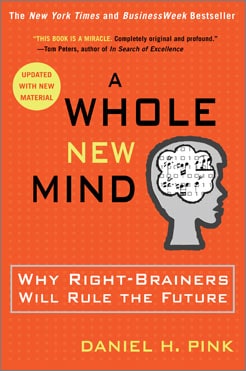


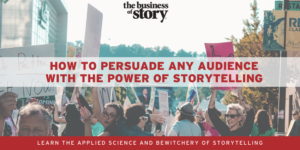







at 11:04 am
[…] Originally Posted on Park Howell: The Power of Storytelling. […]
at 8:42 am
I love examples of business story writing that don’t just talk about what to do, but actually walk the talk. This could easily have been four or five posts that you rolled into one. I even recognize Campbell’s influence as you shared your transformation. Looking forward to more hero’s mojo when your book comes out.